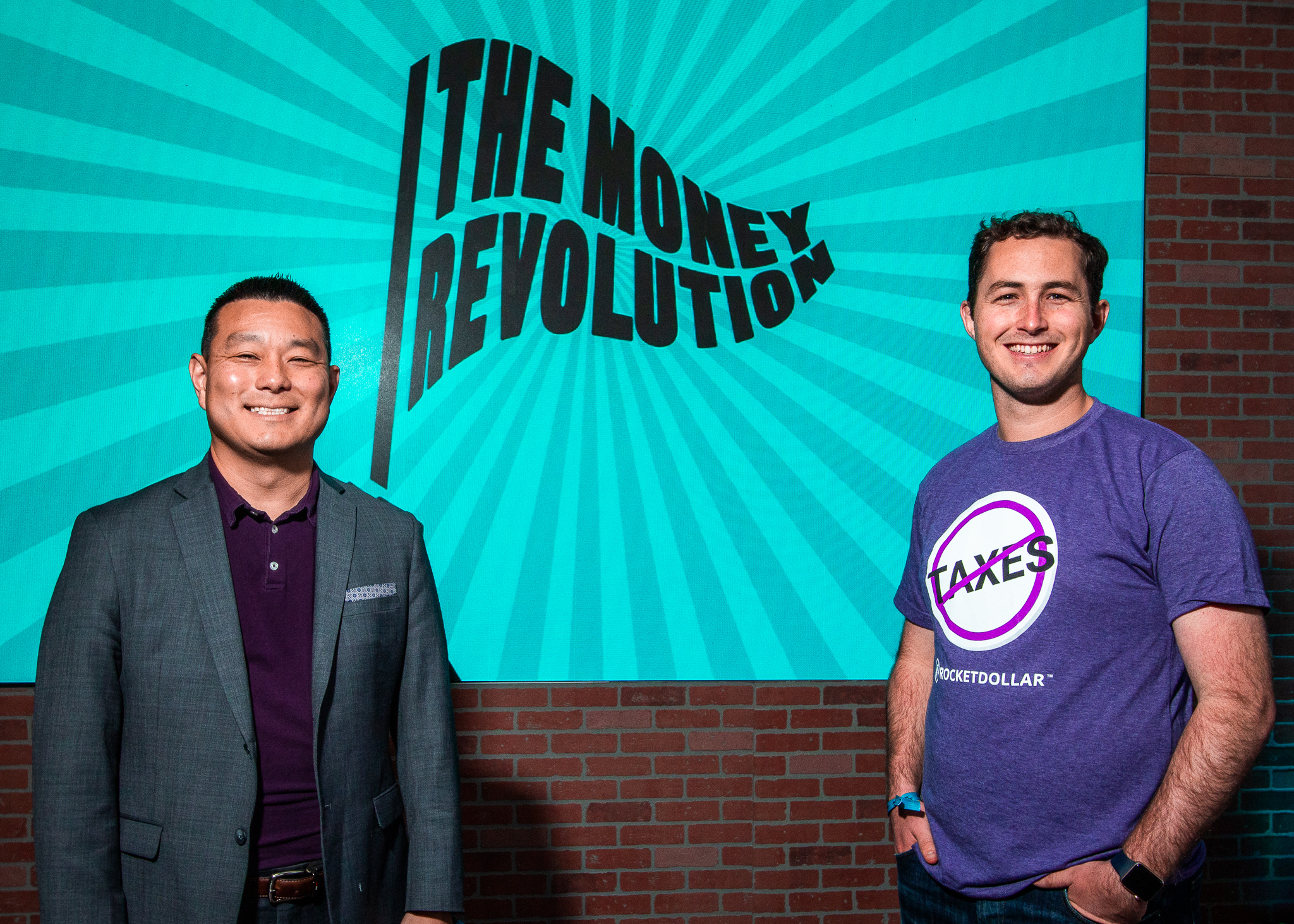How to Maximize Your Retirement Savings with a Self-Directed Solo 401(k)
If you’re self-employed, you understand both the freedom and responsibility that come with running your own business. You may also be eligible to...
13 min read
 Rocket Dollar
:
April 25 2019
Rocket Dollar
:
April 25 2019
Now is the time to reduce investment risk. If you want to gain peace of mind in the shadow of an impending recession, this webinar is for you. You’ll learn about innovative investment opportunities designed to thrive in today’s uncertain and tumultuous economic environment.
In this webinar, Matt Khuri and Ryan Andrews, founders of Aerial Investment Management explain their recession resistant investing strategy.

Ryan Andrews: I'll share just a couple minutes about my background and bio and then I'll get more into the presentation. So I started my career on the institutional investment management side at PIMCO down in their Newport Beach office. They're the big bond and alternatives manager. And that experience really shaped me, in that it gave me early exposure to the importance of macro economics in investing and kind of watching global markets and national markets instead of just looking at individual assets. So spent a number of years there at PIMCO.
I was also an early employee at Crowd Street, if anybody's familiar with that company. They were one of the early pioneers in really crowdfunding private real estate investing and commercial real estate investing online. And then the last several years I launched and managed a construction debt fund where overall I was overseeing a $45 million real estate portfolio and managed capital markets for about 170 investors that we had as part of that fund.
Really all along this, especially starting it, starting my career at PIMCO during the 2008 financial crisis, I really believed in the importance of preparing for a recession of, the impact of macro economics and monetary policy in preparing your portfolio. When Mark and I met a number of years ago and started kind of talking about real estate together and working on this idea, we had a lot of shared, just shared beliefs around preparing for a recession, what kind of assets do well in a recession, how real estate operates.
We started working probably about a year and a half ago on what would become the recession resistant fund. And we had this real shared belief around a lot of the indicators in the macro economic environment that were telling us that it was a really good time to put an investment vehicle like this together. I'll get more into those factors in just a second. But Mark here will share his bio and background.
Mark Khuri: Great. Thanks Ryan. Yeah, Mark Khuri here. So I started out on corporate finance, working as a financial analyst for a Fortune 500 company. That was in early 2000s, and then along the way I began investing in real estate on the side, which is how many people become real estate investors. That was in the mid-2000s. And I held and managed property through the recession. So firsthand experience seeing the greatest downturn of our lifetime.
Then by about 2009, my family and I had been pooling some capital together, really to take advantage of one of the biggest discounts in our lifetime in real estate. And that's when I left corporate America to really pursue my passion for real estate. And what's interesting, along the way I realized and learned and fell in love with self-directed IRAs and what they are and how you can utilize them as an investment vehicle. I opened an account and also learned that you can't actively invest and manage your own deals. So I'm glad I learned that early. You can get in trouble for doing that.
I needed a place to invest my retirement dollars. I ended up going on, really what I call a two-year educational spree. I attended many, many investment seminars and meetings. This is all in Southern California at the time. And started meeting a lot of very savvy real estate operators, where I could invest my personal retirement self-directed IRA capital in real estate. And that's essentially how I got started in self directed IRA investing, was needing a place to invest my capital in an asset and real estate capacity, which I already had very passionate about and fell in love with.
Fast forward over 10 years. As the slide shows here, Ryan and I as a management team, we've got over 25 years combined experience in real estate and investment management. We've been involved in over 200 real estate investments across 10 different asset classes, and we've managed and created over 50 real estate partnerships. I'm just happy to share with you today some of our beliefs and learnings along the way.
Ryan Andrews: Great. Well we like to start here. Like a lot of investors, this is kind of what the economy looks like to US right now. Today, we're in the second longest expansion in us history, and there's some storm clouds on the horizon. As a matter of fact in June, this current expansion that we're in will turn over to be the longest in US history. It'll be over 10 years. We believe it's not just a question of if, it's a question of when. When is the next downturn or recession coming. As investment managers, we're watching several economic forces that could push the US into recession. And while we could probably talk for hours on this subject, we'll just mention a few high level indicators that we're watching right now.
Ryan Andrews: The first is we're watching the cost of living rise really, really rapidly, and the labor markets are also at full employment. And while full employment can be a good thing, because it means rising wages, that can also, the impact of that can mean cost-push inflation because wages is such a big input in goods and services that are sold in the economy. And so the most important takeaway here is it's putting families under pressure. It's just an important indicator to watch.
Second, the US is in an affordable housing crisis. I think we've all seen the cost of housing has increased massively over the last decade. And again, it's left many households under pressure. It's left many households, if they don't own real estate, it's left them behind. This is a really important longterm trend that creates an opportunity for us as investors. So more about that in a minute, kind of through this presentation.
Third, one of the biggest threats to the economy is monetary policy and the speed at which the Fed raises interest rates or even changes its forward guidance, which forward guidance is kind of a fancy term for them coming out and telling us when they think they're going to change interest rates. And this alone could tip the economy into a recession. Some of what the Fed came out with in their recent meeting in this last month showed that the Fed is looking at a lot of indicators that look like a recession could be on the horizon. They tap the brakes, so to speak, on raising interest rates. They said most likely no interest rate increases for the next year and maybe there'll be one in 2020. They most likely wouldn't have done that if they didn't see weakening in the economy. Just another couple indicators.
Then lastly, this is kind of a fun, or if not fun, at least an interesting one. On March 22, so just about a month ago, the yield curve inverted, and this was the first time it's inverted in a decade. And what that means is short-term interest rates on the three month Treasury note was above the interest rate on the 10 year Treasury note. And this is a commonly accepted and known leading indicator for recession. So matter of fact, an inverted yield curve has preceded each of the past seven recessions, and that's been over the last 50 years. Just as an interesting stat, when the yield curve has inverted, a recession has followed between 200 and 400 days after that. You're talking about one year later, typically a recession occurs. That's just an important indicator that caught a lot of folks attention at the end of last month.
Given all these indicators, we truly believe now's the time to reduce investment risk. Today we are investing in real estate that has a low correlation to market volatility. Specifically we're selecting stabilized commercial real estate investments that generate immediate cash flow and which have a really strong value-add component. And this means that we can improve the property and increase the net operating income rather than relying solely on market appreciation.
Our strategy also focuses heavily on the longterm sustainable demand that's the result of the affordable housing crisis I mentioned a moment ago.
Mark Peck: Yeah, thanks for that, guys. All really interesting points and I think they all come to a head oftentimes when somebody's constructing a portfolio. And in particular, in a retirement account portfolio, you've got some specific duration concerns and sort of everyone's got their own goals for their trying to achieve. I think there's a couple of interesting times where assets such as the ones that we're touching on today really come into play.
I think of my own situation, the way that I've invested my own self-directed account. I've got some pretty high risk, high reward opportunities with some startups and early stage companies that don't leave me with a lot of good cushion or good mitigation of risks on the other side. So I think if you're pursuing some high risk strategies, it's great to pair something like with the recession resistant fund with those assets. That way that you're getting a more true baseline with some concrete physical assets backing those things up, providing some yield and providing some income in a more consistent manner. So really just to smooth out your retirement return portfolio profile, I think it can be useful there.
As well as can really help you focus in on specific geographies and specific asset classes, which is what Mark's going to touch on further. And that just really helps you invest in what you know and what you feel comfortable with as well. And that's I think really important for folks who are actually nearing that retiree stage, right? As you look to transition your portfolio away from a stock heavy or growth heavy portfolio towards more of an income generating, smooth return portfolio, it really helps to be able to tap into some specific asset classes and geographies and add those to your other pieces of the portfolio so that you've got really true diversification, which is often so difficult to obtain in the public markets. I think that's where we see a couple of really good use cases for these kinds of assets within a retirement account.
So Mark, if you want to touch a little bit on some of those asset classes, I know we've got a few on the screen here, so go ahead and dive in the specifics.
Mark Khuri: Sure. Yeah. Again, about 14 years ago I started investing in real estate, at that time with just friends and family. And over the years we've invested across lots of different asset classes. Numerous strategies, flipping, buying and holding rentals, et cetera.
But today, and actually for the last couple of years, accounting for the economic headwinds that we've seen and based on our experience, we've selected and narrowed down our investment focus to just three asset classes, which you can see on the screen. And those are mobile home parks, workforce apartment housing, and self-storage facilities. And our fund combines the three of them into one investment vehicle.
Let's just review why do we love these three. This chart's great. Over the last decade, our three asset classes have seen the highest net operating income growth when you compare them across 10 different types of real estate. And this is projected to continue. This is a chart from Green Street Advisors. So yeah, let's dive in a little more. Why these three? And why are they continuing to show great NOI growth?
We'll start with mobile home parks. Mobile home parks continue to be one of our favorite asset classes. There's several reasons why. It comes back to the affordable housing crisis, which is apparent nationwide. I'm sure many listeners today have seen it and felt it in their backyard. But mobile home parks are the most affordable housing solution. Even recently we've seen a surge in demand for mobile homes from baby boomers who are retiring on fixed incomes.
Further, supply of mobile homes is restrained. This is due to zoning restrictions, limiting the development of new mobile home park communities in desirable areas. Now within the asset class we focus on a unique business model where we want to own primarily just the land and not necessarily the homes. And lastly, mobile home parks are one of the highest cash flowing real estate assets, and they provide unique tax advantages, including accelerated depreciation.
Here's a quick case study. It's always good to look at examples, I believe. But we began investing with a mobile home park operating partner over six years ago. And here on this slide you can see we summarized one of our investments, which consisted of an ownership in 15 mobile home parks across six states. It was a portfolio which provided consistent, predictable cashflow with a strong upside. That's really what we look for. Diversification, like you said, Mark. Predictable cashflow, in place income. And this example in 2008, our operating partners sold over a hundred mobile home parks for over 340 million to a private real estate equity group, which provided investors over 13% IRR, an 80% return on investment.
So the second asset class we touched on was workforce apartments. Workforce housing also is an affordable housing solution. And when we talk about workforce apartments, what we're meaning and what we are referring to is rental housing apartments that can be reasonably afforded by the middle income, local population. Workforce housing often has high demand and consistent occupancy during an economic correction. A typical sweet spot I'd like to just share with people is, estimate that the rental rate per month is going to be between 800 and $1,200 a month. So that's kind of how you can get an idea of the class of apartments we're talking about. Further, with home ownership at its lowest rate in over 50 years, more and more people are choosing to live in apartments.
This is an example that we made recently. This is in Austin, Texas. Actually, Mark, in your backyard. It consists of a 284-unit institutional building, a community that was built in 2002. It's seven miles from downtown Austin. And the property, when we bought it at acquisition, was 94% occupied and generating positive income. It is part of our recession resistant fund.
A little bit about the business plan that we like to employ, which Ryan touched on, the renovation of the units and bringing them up as far as quality and to market. Prior to acquisition, 59 of these units had already been renovated by the previous owner, and they were generating over $200 more per month in rental income than the non-renovated units. We had already had a pretty well proven model at this facility to be able to come in and renovate the remainder of the units and the exterior grounds to increase the net operating income.
The goal of this was, this project, is to raise the NOI from 2 million to about 3.4 million by year seven. So we're about the first a few months into this project and upgrades have already begun, and the first remodeled unit was rented out at $86 more per month than projected. So off to a good start and love this apartment community.
Another property here, another example. 2016 we invested in this 384-unit property in Richmond, Virginia. It was built in 1980, has 13 buildings on over 17 acres. And the value-add business plan has grown the net operating income. So same concept. You come in, renovate units, provide a higher quality unit, and it resulted in a 13% increase in value of the property in just two years. What you do after that, you grow the NOI. And then last year we refinanced the property, which returned to investors about 15% of our capital. Now we still own and invest in this property. And we have currently earning over 10 and a half percent cash on cash annually at this facility.
Okay. So the third asset class that we love, self-storage. Self-storage provides stability during a downturn. Let's talk about why and how. If you think about during tough times, more people tend to have life events that results in a physical change, requiring the need for storage. If you think about foreclosure or change in employment, downsizing, moving home from college, et cetera. All of those impact the demand for storage. And then one thing we really love. Due to the 30-day lease, self-storage can adjust to the market very quickly. And the demand is massive. One out of 11 Americans currently pay over $90 per month for storage.
Now, if you look back during the great recession in 2008, the last bullet point on this slide, a self storage REITs were generating a 5% positive return, while general REITs realized a 38% loss. So you can imagine if you just held self-storage REITs, the outcome probably would have been much different for most investors in 2008.
Okay. Here's an example of a case study. We've been investing in self-storage for six or seven years now with a national developer and asset manager that has over 45 years experience just in self-storage. They're estimated to collectively be the 28th largest operator of self-storage in the US. We've got over 30,000 total spaces. And their focus is primarily on value-add self-storage facilities, which is what we love. And like all investments that we target for our fund, this example you see on the screen here was a value-add opportunity where we increased physical occupancy and the gross rental income and took a 517-unit facility that we bought in 2015 for 7.5 million and sold it in 2018 for 8.7 million. So that provided investors with a 25% average annual return.
We just wanted to also outline the performance of these three asset classes that demonstrates our experience. So this chart includes 26 investments that we've made just in our three asset classes. And what you'll see is as of the end of Q4, 7.7% was the average cash flow along the 20 investments that we currently still hold. That's from rental income. And then last year we had five investments exit. We just shared one with the self-storage facility. They all provided a 19.4% average internal rate of return. So Mark, want to turn it back over to you. Happy to answer any questions and again, appreciate your time today.
Mark Peck: Yeah, thanks so much guys for speaking on those use cases. I think it's really powerful to see the specific sort of examples of how those assets, how they behave and what you can expect. I think again, just to sort of bring it all back together folks, I see we've got a couple of questions, coming into the queue, so we appreciate that. But ultimately, really, Ryan and Mark's expertise here from an asset manager perspective is helping you apply some of those lessons and themes that Ryan touched on from a macro economic perspective, and just letting you drill down into the specific asset class. And I think that's what's so powerful about these opportunities, is it's not a very high level generic traded REIT or something of that nature, but really getting access to something very specific that's uncorrelated to other aspects of the market.
I think that's what we loved so much about it from retirement perspective. I know we get a lot of interest in all three of those asset class areas and obviously for consolidated funds such as the recession resistant fund. So thanks for the information there guys. So I'll kick it off here. We've got a couple of questions, and thanks again and feel free to chat in any new ones in. If you guys can use the toolbar at the bottom of the webinar there, thanks so much. But it looks like the first one here, I'm probably going to give it to the Aerial guys. Since you've discussed a few different asset classes, Mark, is there one that stands out to you as the best opportunity for today's consumer conditions or maybe for the next couple of years?
Mark Khuri: Sure, yeah, I would say mobile home parks. Lots of reasons, but essentially it's hard to find an investment where you have consistently growing demand and flat or decreasing supply. And when you put those two metrics together, it's just got a very long term growth that we believe we'll see and experience for many, many years to come. Further, it's like we visited, and we walk, and we invest in a lot of different mobile home parks, but there's often a misconception about them as to what they're like, what the quality is, the resident base, the tenants, et cetera. And we were concerned about that many years ago before we started investing in mobile homes. But over the years we've just learned so much more about the asset class and continue to love it more and more.
Now of course there are some mobile home parks that are less attractive in less desirable areas that might be a little tougher to manage. We tend to steer away from some the really heavy lifting properties. We're looking for highly desirable locations with a strong resident base. And essentially what you find there that I love is that they're really communities. Most of the residents know each other. They're very much in touch with each other on a day to day basis. They look out for each other. And it's just great to be able to walk them and talk to people that live there and see how much they appreciate being able to live and own their home, obviously during a time where the cost of home ownership is just absolutely skyrocketed. So for some of those reasons, and we believe the longterm aspect of the asset classes is extremely strong. I would say that mobile home parks are probably our favorite.
Mark Peck: Yeah, that's interesting. You made a point before I hadn't considered before, which is the shifting demographics on the older age spectrum for mobile homes. I think some people, like you said, have preconceptions about the population there, but that's not something I would have thought of. And it makes a lot of sense, particularly in overcrowded urban areas where you need some relief there. And the fixed income earner, or the fixed income living folks then retire and retirement makes a lot of sense for them.

If you’re self-employed, you understand both the freedom and responsibility that come with running your own business. You may also be eligible to...

In today’s investing landscape, many individuals are asking the question: What are the benefits of investing in alternative assets? As traditional...

Alternative asset investment is no longer reserved for hedge funds and institutional players. Thanks to platforms like Rocket Dollar, everyday...

Outside of a few tech darlings, investment growth opportunities in the public equity markets are scant. The only way to truly achieve solid returns...

Angel investors are often the lifeblood of early-stage and startup businesses. In addition to providing much-needed capital, angels also typically...

2 min read
If you want to make a successful and highly profitable real estate investment, there are some key factors that you should consider before choosing an...